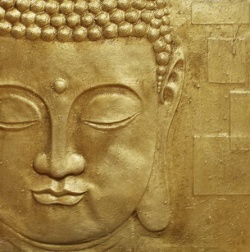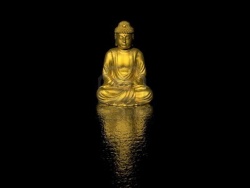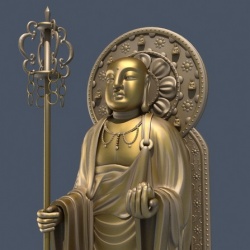Sautrāntika
The Sautrāntika were an early school of Buddhist Philosophy, generally believed to be descended from the Sthaviravada by way of their immediate parent school, the Sarvāstivādins. Their name means literally "those who rely upon the Sutras", and indicated their rejection of the Abhidharma texts of other Early Buddhist schools. The Sarvāstivādins sometimes referred to them as the Dārṣṭāntika school, meaning "those who utilize the method of examples". This latter name may have been a pejorative label. It is also possible that the name 'Dārṣṭāntika' identifies a predecessor tradition, or another related, but distinct, doctrinal position; the exact relationship between the two terms is unclear. Charles Willemen identifies the Sautrāntika as a Western branch of the Sarvāstivādins, active in the Gandhara area, who split from the Sarvāstivādins sometime before 200 CE, when the Sautrāntika name emerged. Other scholars are less confidant of a specific identification for the Sautrāntika; Nobuyoshi Yamabe calls specifying the precise identity of the Sautrāntika "one of the biggest problems in current Buddhist scholarship."
Sautrantika The higher of the two schools of Hinayana tenets. This school accepts both self-cognizers and external objects to be truly existent.
The Sautrantikas have their base on the Sutras who contain for them the teachings.
There are Sautrantikas :
- The followers of the scriptures like Vasubandhu
- Those who reason like Dignaga and Dharmakirti.
Further:
1. Cause and result cannot exist simultaneously
2. Consciousness does not perceive its object “naked”, but is generated due to its imaginations
Here is the latter point the main difference between Prasangika Madyamika and Sautrantika, that regarding the latter above mentioned point 2 , the Prasangika Madyamika are convinced that the external objects do exist in a conventional way. Their conventional way is a part of the 2 Truths (Rog gi ban sde) namely the absolute and the conventional truth.
Convention – (Kun dzob)
- Correct convention ( Yang dag pa’I kun rdzob ) – That which is able to function according to its appearence
- False convention (Log pa’I kun rdzob) – That which lack the ability to function according its appearence
The other schools are not convinced about the point of view of the Prasangikas and adhere to the position that the external objects do not exist as such, as they "APPEAR" to the mind of karma.
But to what they all the Vaibhashika's, Sautrantika's, Chittamatrins and Madyamika's agree to, are these 4 seals:
1. All objects / phenomenon are impermanent and disintegrate at some time
2. All contaminated objects are sorrow etc. . These are the states of consciousness, which relates the objects with an independent existence
3. All phenomenon are without a self because the interdependency they cannot exist on their own.
4. Nirvana is peace
Sautrantika school
経量部 (Skt; Jpn Kyoryo-bu)
One of the twenty Hinayana schools. The Sautrantika school broke away from the Sarvastivada school. Unlike the Sarvastivadins, who valued abhidharma works, or Buddhist treatises, the Sautrantikas relied only on the sutras. Whereas the Sarvastivada school held that the dharmas, or elements of existence, are real and have an abiding existence of their own, the Sautrantika school taught that the dharmas have actual existence only in the present and that only the present exists. The Sautrantika doctrine is similar in several aspects to Mahayana thought and is regarded by some scholars as the origin of the Consciousness-Only, or Yogachara, teaching because the two share in common the concept of "karmic seeds," the causes or sources of all phenomena, which are inherent in life.
According to the Abhidharmakośa of Vasubandhu, the Sautrāntika held the view that there may be many Buddhas simultaneously, otherwise known as the Doctrine of contemporaneous Buddhas.
The Sautrāntika differed from their parent school, the Sarvāstivādins, on matters of ontology. While the Sarvāstivādins Abhidharma described a complex system in which past, present, and future Phenomena are all held to have some Form of their own existence, the Sautrāntika subscribed to a Doctrine of "extreme momentariness" that held that only the present moment existed. They seem to have regarded the Sarvāstivādin position as a violation of the basic Buddhist principle of Impermanence (Anicca). The Sarvāstivādin Abhidharma also broke down human experience in terms of a variety of underlying Phenomena (a view similar to that held by the modern Theravada Abhidhamma); the Sautrāntika believed that experience could not be differentiated in this manner.
They used the concept of an āśraya (substrate, Refuge) to explain the continuity of Consciousness through Rebirth, whereas the Pudgalavādins and the Vātsiputrīya school posited a pudgala (a 'personal entity' distinct from the five Skandha), and where non-Buddhist Indian philosophy typically referred to an ātman. Vasubandhu, one of the Indian monastic scholars primarily responsible for articulating the doctrines of the Yogācāra School, was sympathetic to the Sautrāntika on many doctrinal issues, and wrote critiques of the Vaibhashika tradition from a Sautrāntika perspective.
No separate monastics code specific to the Sautrāntika has been found, nor is the existence of any such separate disciplinary code evidenced in other texts; this indicates that they were likely only a doctrinal division within the Sarvāstivādin school.
The theory of Perception that is commonly attributed to the Buddhist Sautrāntika school, or system, holds that a number of atoms of e.g. colour/Form produce an instance of perceptual cognition, together with a sense-faculty and a preceding moment of Consciousness, often referred to as manaskāra. In the case of visual Perception, extraneous factors such as Light serve as additional causes. In sum, a set of causes, all of which have momentary existence, produce a Perception; this Perception, in turn, is characterised by having the shape of the object-cause, or appearing in the object-cause’s Form (ākāra).
There is clearly a representationalist element in this theory of Perception: a Perception is one of a blue object because it has the appearance of the external blue object that caused it. A philosophical question that arises in connection with this theory is whether it can be classified as a “sense-datum theory”. Is the object’s “shape” or “Form of appearance” (ākāra) a sensedatum? Can the Sautrāntika’s theory be paraphrased such that we don’t perceive external objects directly, but rather perceive their representations in Consciousness?
It seems to me that such a paraphrase is imprecise. One of the peculiarities of the Sautrāntika view is that it operates much like a scientific theory that explains Phenomena which we describe in ordinary Language reductively through higher-order Phenomena. A scientist might claim that what ordinary people refer to as water is really H2O. The Sautrāntika claims, likewise, that what we think are gross and unitary objects of Perception, like jars, are really aggregated atoms, or that what we believe are enduring cognitive subjects are really series of moments of Consciousness.
Likewise, in the case of Perception, several operations are at work when ordinary Language accounts of the Phenomena like “I see a blue patch” are accounted for: what actually happens is that a set of momentary causes gives rise to a Perception that has a certain representational relationship to some of these causes (and not to others). Once we are in this theory, it no longer makes sense to argue that we see anything: there is no action of seeing that is undertaken by anyone; there is just a momentary instance of Perception that is produced from its causes.
Similarly imprecise is the claim that, according to the Sautrāntikas, we do not perceive reality, but only infer it – that Perception is really an act of inference. It is true that the status of external objects which are made up of matter (though matter conceived of in a peculiar way!) and exist independently of perceiving minds becomes problematic in Sautrāntika-style epistemologies. The problem which Dharmakīrti succinctly raises in his Pramāṇaviniścaya is: how can the Sautrāntika establish that what causes a Perception that appears in a certain way is, of all things, an external object? According to Dharmakīrti, the Sautrāntika can’t, and an idealist theory of Perception that regards the object-cause as something internal is just as plausible as the Sautrāntika’s flirtation with external matter.
But what remains is this: the Sautrāntika, as Dharmakīrti presents him, produces an inference in order to prove the existence of external objects of Perception. He does not claim that Perception is inference – that, subjectively speaking, when we believe we perceive a patch of blue we really perform an act of inference.
The followers of the Sautrāntika accept only the sūtras of The Buddha as authentic teach-ings. Tey do not accept the texts of Abhidharmacomposed by Kātyāyānīputra and others as the words of The Buddha or Buddhavacana. When de-fining Sautrāntika, Yaśomitra says:
kaḥ sautrāntikārthaḥ ? ye sūtraprāmāṇikāḥ,na tu śāstraprāmāṇikāste sautrāntikāḥ ?
Paraphrasing: Who is a Sautrāntika? Tose who consider only the sūtras as valid (teachings of The Buddha), not the commentarial literature, are called Sautrāntikas.Terefore the Sautrāntikas consider only sūtrasto be the authentic teachings of The Buddha. As the name itself suggests, the Sautrāntika emphasizes the authority of the Sūtra of the Āgamapiṭaka over the proliferating Abhidharma literature which they saw as the work of later authors and not the authentic words of The Buddha. Sautrāntikas are also called Exemplifiers (dārstāntika). So in other words, there are reasons for their being called Sautrāntika) and Exemplifiers. They are called‘Sautrāntikas” because they propound tenets chiefly in reliance on The Buddha’s Sūtras without following Explanatory works (śāstras). They are called‘Exemplifiers’ because they teach all doctrines by means of examples. Tis is not to say that the Sautrāntika repudiates the Abhidharma piṭaka. Abhidharma philosophy remained a valid system of reflection upon The Buddha’s teachings, but were not as authoritative as The Buddha’s verbatimteachings in the general discourses (sūtras). Tusthe name Sautrāntika, “those who rely upon the sūtras,” indicates a rejection of the authority that
ESSENTIALS OF SAUTRĀNTIKA PHILOSOPHY
MILAN SHAKYA
the Sarvāstivādins bestowed upon their separate canonical Abhidharma collection.Sūtra is also called Sūtrānta (Pāḻi: Sūttānta). In other words, the theories propounded on the basisof the Sūtra are called Sūtrānta. Te Buddhist Philosophy associated with Sūtras and Sūtrāntas are called Sautrāntika. Sūtras are the words of Buddha intended to work for the benefit of sentient beings. Just as a garland may be made either of pearls, golden beads, emerald and other precious stones, Sūtras are also delivered by the Enlightened one to Sentient beings of various predispositions and Mental inclinations.
Sautrāntika, ancient school of Buddhism that emerged in India about the 2nd century bc as an offshoot of the Sarvāstivāda (“All-Is-Real Doctrine”). The school is so called because of its reliance on the Sutras, or words of The Buddha, and its rejection of the authority of the Abhidharma, a part of the canon.
The Sautrāntikas maintained that though events (dharmas) have only momentary existence, there is a transmigrating substratum of Consciousness that contains within it seeds of goodness that are in every person. The Sautrāntika sometimes is characterized as a transitional school that led to the development of the Mahāyāna tradition, and many of its views influenced later Yogācāra Thought.



